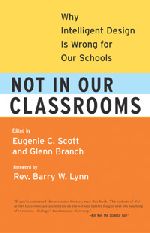
You are hereIn the Latest NewsletterAnarchy EvolutionNew York: HarperCollins, 2010. 304 pages. In Anarchy Evolution, Graffin, a punk rock star and a biologist, “presents his own naturalistic worldview in semi-autobiographical form” along with explanations of evolution, reviewer Richard P. Meisel explains. “Each component is compelling in its own right but the connections among these elements often come off as contrived.” While the treatment of evolution was for the most part solid, Meisel thinks that Anarchy Evolution will primarily appeal to fans of punk rock. Creation: How Darwin Saw the World and Changed it ForeverSanta Monica (CA): Lionsgate, 2009. 108 minutes. Of these two cinematic accounts of Darwin’s life, reviewer Timothy H. Goldsmith prefers Darwin’s Darkest Hour. “It ... offers a more elegant presentation of evolution by natural selection, often accompanied by stunning photography.” Creation, in contrast, presents “at best a narrow and at worst a distorted picture of Darwin,” and a less satisfactory explanation of natural selection. Darwin’s Darkest HourWashington (DC): National Geographic Television, 2009. 90 minutes. Of these two cinematic accounts of Darwin’s life, reviewer Timothy H. Goldsmith prefers Darwin’s Darkest Hour. “It ... offers a more elegant presentation of evolution by natural selection, often accompanied by stunning photography.” Creation, in contrast, presents “at best a narrow and at worst a distorted picture of Darwin,” and a less satisfactory explanation of natural selection. Evolution, Creationism, and the Battle to Control America’s ClassroomsCambridge: Cambridge University Press, 2010. 304 pages. “Natural scientists … often react with disbelief and dismay when they read polls about how many Americans do not believe in human evolution and resist its teaching in public schools. They’re not sure what (if anything) can be done about it in our exceptionally religious-minded society,” writes reviewer George F. Bishop. “But it may take highly capable political scientists, such as Berkman and Plutzer, to pave the way to effective reform by telling us what goes on behind those classroom doors, and why. Required reading, I’d say, for everyone who truly wants to make a difference in the ‘Battle for America’s Classrooms.’” Marketing Intelligent Design:New York: Cambridge University Press, 2011. 360 pages. Reviewer Tim Beazley describes Marketing Intelligent Design as arguing that “the ‘intelligent design’ movement (IDM) is not really a serious attempt to advance a scientific alternative to evolutionary science, but rather a slick marketing plan designed to evade the judicial interpretations of the First Amendment’s Establishment Clause that prohibit religious proselytizing in public elementary, middle, and high school science classes.” He concludes, “Overall the book is excellent,” and very helpful for anyone interested in the constitutional issues surrounding “intelligent design,” at the same time expressing a few reservations about the usefulness of the citations and Ravitch’s tolerance for the dishonesty of intelligent design creationists. No Dinosaurs in HeavenNew York: Jezebel Productions, 2011. 53 minutes. “No Dinosaurs in Heaven addresses concerns about who is teaching students what in classrooms across America — a cultural conflict that has been flaring up off and on for decades,” writes reviewer Brandon Haught. While Haught appreciates the two storylines involving NCSE’s rafting trip through the Grand Canyon and Schiller’s own experiences with a science education professor who rejects evolution, he finds the film to be too narrowly aimed at the partisans of biblical flood geology, and overall unfocused. The Neighborhood ProjectNew York: Little, Brown, 2011. 448 pages. Reviewer Richard F. Firenze writes that Wilson “is suggesting that by reading the directions, written in the language of evolution, and working with what’s on the table, a species honed for survival and reproduction on the African savanna by what he calls the ‘hammer blows of natural selection’ ... can create not just a better city … but in fact a better world. … He cogently argues that we can use evolution both to understand and to improve the human condition, and that evolutionary science can and will (if he has his way) deliver practical answers to the problems of everyday life.” |
NCSE T-shirts  Project Steve t-shirts can now be ordered online at the NCSE Store.
Project Steve t-shirts can now be ordered online at the NCSE Store.
Voices for Evolution Staff Publications  by Eugenie C. Scott  edited by Eugenie C. Scott and Glenn Branch  by Peter M. J. Hess and Paul L. Allen |